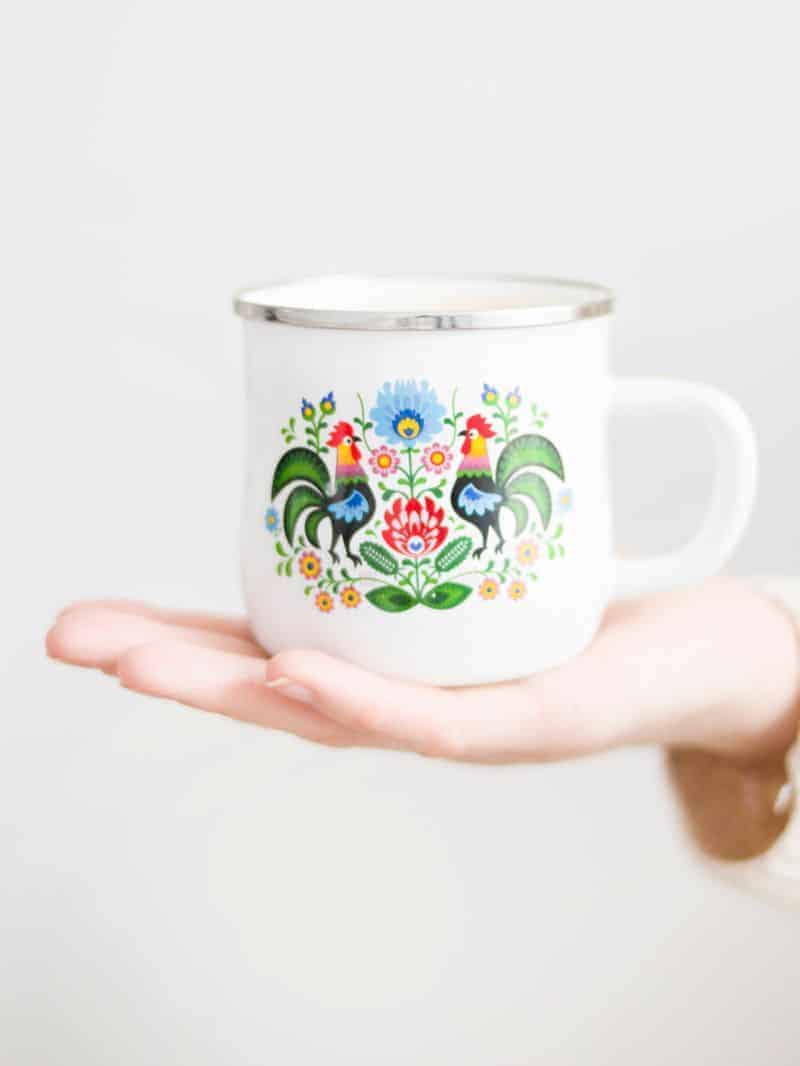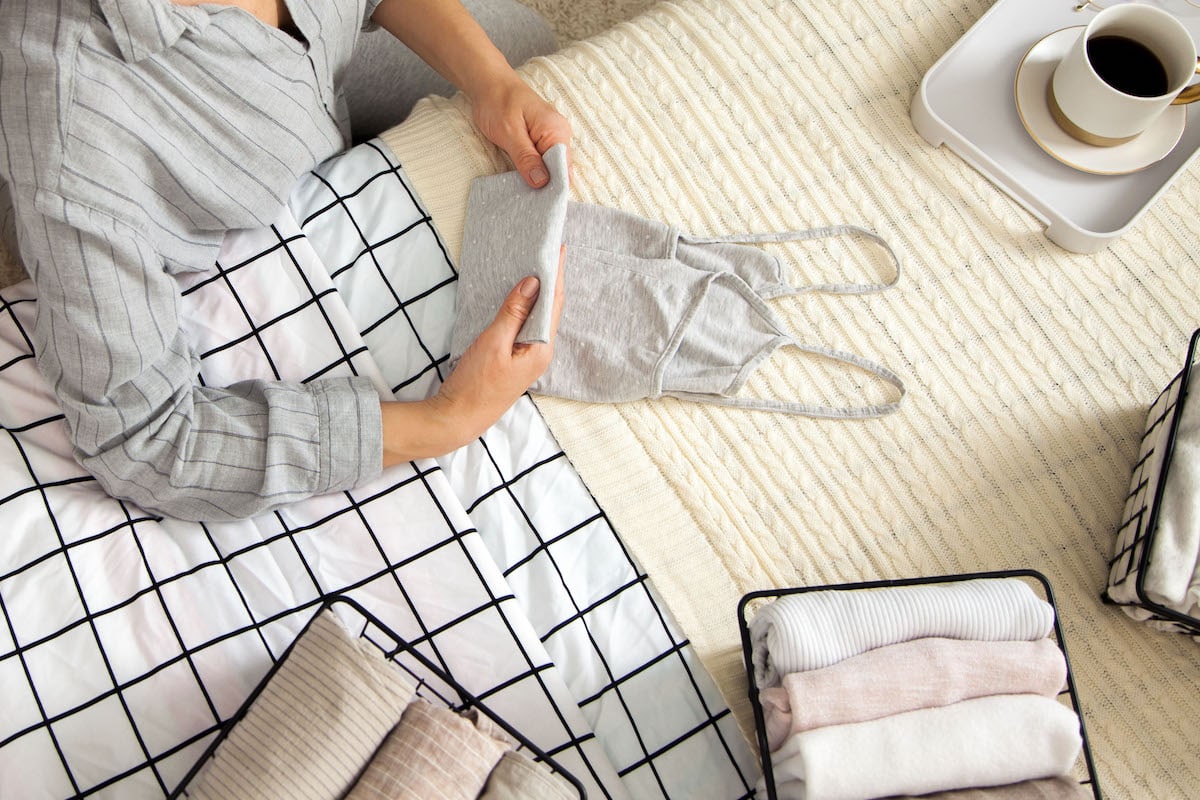What is the KonMari Method? 20 Do’s and Don’ts
This post may contain affiliate links for your convenience. That means that if you make a purchase, I will receive a small commission at no extra cost to you. Read more here.
Marie Kondo’s book The Life-Changing Magic of Tidying Up: The Japanese Art of Decluttering and Organizing isn’t just a book — it’s a revolution! The KonMari Method declares an all-out war on the tyranny of stuff in a world of McMansions and wanton clutter.
Her KonMari decluttering method is accompanied by the claim that not only can it clear your clutter now but it can also prevent the future collection of clutter in its tracks.
You can decide for yourself if that’s true or not after trying it out yourself. To get you started, here are 20 essential do’s and don’t for decluttering your home with the KonMari Method.
READ MORE: 101 Marie Kondo Quotes & Sayings to Spark Joy in Your Life

What is the KonMari Method of decluttering?
Marie Kondo’s decluttering method isn’t just a method; it’s an entire philosophy.
The KonMari Method of decluttering is a revolutionary system of simplifying your home; you begin by discarding physical items that do not bring you joy so that you can surround yourself with only those items that do spark joy.
The KonMari Method encourages decluttering and tidying by category rather than location, keeping only those items that speak to your happiness.
This method was pioneered by Mari Kondo and introduced to the world in her book The Life-Changing Magic of Tidying Up.
Marie Kondo herself that your decluttering should begin and end with a single question:
The approach is rooted in a single question: Does this item spark joy? Identifying what sparks joy leads to a tidy home filled only with items you cherish. It’s also a path to self-discovery, mindful living and fulfillment.
Marie Kondo
What are the steps of the KonMari Method?
According to Marie Kondo, there are six basic rules for decluttering and organizing your home with the KonMari Method.
KonMari Method steps:
- Commit to tidying up
- Visualize your ideal lifestyle
- Finish discarding first
- Tidy by category, not location
- Complete categories in the right order
- Ask yourself “Does this spark joy?”
Confused? You can read more about the KonMari categories and grab a free checklist here if you need more guidance.
⚠️ WARNING! Side effects of decluttering may include excessive joy, an intense awareness of spaciousness, and a sudden feeling of contentment and peace!!!
KonMari Method Do’s and Don’ts
Take it from someone who started decluttering with the KonMari Method and then extreme decluttered her entire home down to eight suitcases to move to Europe – decluttering is a lot more complicated than those six simple rules make it sound!
Here are some key do’s and don’t that accompany that underlying philosophy of sparking joy.
You’ll also find helpful exerts and quotes from The Life-Changing Magic of Tidying Up sprinkled throughout this article to help clarify each of these tips.
1. Do visualize your goals
If you have ever played sports, competed in academic events, participated in business conferences, or performed yoga, you may already be aware of the power of visualization.
So is Marie Kondo.
An essential first step to tidy up like Marie Kondo is to visualize your ultimate goals in concrete terms; if you don’t, Kondo warns you might risk decluttering delays or even rebounds!
Goals like “I want to live clutter-free” or “I want to be able to put things away” are too broad. You need to think much more deeply than that. Think in concrete terms so that you can vividly picture what it would be like to live in a clutter-free space.
Marie Kondo
Seeing is believing, even if it’s in the mind’s eye.
Before you even grab a single sock off the floor, take a moment to sit quietly, without any distractions, and try and visualize what your ideal life would be like if your home was properly decluttered.
Picture your home in your mind’s eye, imagine where items might be placed, the open spaces, and also the feeling you are searching for — do you want your home to be a relaxing oasis or have an upbeat, energetic feel?

2. Don’t take too long
The KonMari Method encourages a sprinter’s pace, not a marathon.
Marie Kondo’s experience has taught her that by attacking clutter at full speed, you will be able to not only eliminate clutter in a short time span but ultimately also change your mindset towards clutter and empower yourself to maintain order in your space after decluttering
Tidy a little a day and you’ll be tidying forever.
Marie Kondo
In practice, however, how long it takes to declutter your home with the KonMari Method really depends on a lot of factors, such as much stuff you have, how big your home is, how many people live in your home, and more.
It stands to reason that a college student living in a 550 square feet studio apartment in New York City will spend less time decluttering than a family of six living in a 2,600 square foot house in the suburbs.
As a busy mother, I have found the more hands on you are with selling, donating, and giving away unwanted clutter, the more time it will take!
3. Do make tidying a special event
If you do everything right with the KonMari Method, you won’t have to tidy your home every day. You may be shaking your head in disbelief (believe me, I was too) but according to Kondo:
Tidying should be completed once and for all within a single period of time
Marie Kondo
Day-to-day tasks of returning items to their place will always occur by necessity, but the actual event of putting your house in order should have lasting effects that keep it tidy and minimize the need for you to tidy on a daily basis.
While embarking on this decluttering journey you are encouraged to dress as if it is a special event. Put on a nice outfit, do your hair, and your makeup.
Put your game face on and your best foot forward as you prepare to joyfully declutter your home.
4. Don’t change up the category progression
KonMari focuses on decluttering items by category, not location, and adheres to a very specific progression.
Don’t attempt to change up the sequence or you risk undermining your ability to completely declutter and tidy your home.
What are the KonMari categories?
There are five KonMari categories:
- Clothing
- Books
- Papers
- Komono (miscellaneous items)
- Mementos
Tidying within each category rather than by specific location yields a very tactile and visible sense of achievement, and also helps with organizing and storing the items after they have been sorted.
The KonMari categories have been specifically arranged from least sentimental to most sentimental for maximum decluttering success.
I myself was surprised by the order and it wasn’t until I found myself in tears over stacks of papers that I fully understood the genius of these categories.
While the progression of the categories might not work for everyone, it’s a solid guideline that most people can appreciate!
Psst! Grab your FREE copy of the most comprehensive KonMari checklist ever and don’t miss decluttering a single item!
5. Do hold each and every item
This key step is part of what separates the KonMari from other minimalism and decluttering philosophies.
Each and every item should be removed and laid upon the floor or other work surface.
- All kitchen and pantry items should be removed from shelves and cabinets.
And so on and so forth.
At that point, you will take every single item in your hands and ask yourself: “Does this spark joy?” If it does not you are free to discard the item.
Here’s what Kondo has to say about this crucial step:
I chose this standard for a reason. After all, what is the point in tidying? If it’s not so that our space and the things in it can bring us happiness, then I think there is no point at all. Therefore, the best criterion for choosing what to keep and what to discard is whether keeping it will make you happy, whether it brings you joy.
Marie Kondo

6. Don’t focus on what to get rid of
The getting rid of part is immaterial.
Focus on what to keep and the rest can be naturally discarded.
Thoughts and emotions that may arise when decluttering include:
- Fearful thoughts: But what if I need this later?
- Guilty thoughts: But it’s a waste to get rid of this, I spent so much money on this, etc
- Hopeless thoughts: There’s no point in even starting because I can’t finish
Marie Kondo recognizes that it can be difficult to discard items, especially if you have a nostalgic or sentimental attachment to them.
It is human nature to resist getting rid of possessions.
When you come across something that you cannot part with, think carefully about its true purpose in your life. You’ll be surprised at how many of the things you possess have already fulfilled their role. By acknowledging their contribution and letting them go with gratitude, you will be able to truly put the things you own, and your life, in order.
READ MORE: 20 Signs You are a Sentimental Person – Good or Bad?
7. Do trust your gut
Instead of focusing on rules like, “Get rid of clothes you haven’t worn in two months” or “Discard one item a day”, you should instead focus your energy on identifying those items that bring you joy and surround yourself with them.
No one else knows whether an item makes you happy or not.
Often we keep items because we feel guilty about getting rid of them, because we are afraid we might need them in the future because we don’t know what to do with them, or some other rationalization.
What are the chances you are actually going to use those craft supplies that have been collecting dust in your office? That you are going to read that book which you purchased three years ago? That you are ever going to get around to fixing that broken toy?
In their own beautiful way, even items we never get around to using have their purpose:
If you missed your chance to read a particular book, even if it was recommended to you or is one you have been intending to read for ages, this is your chance to let it go. You may have wanted to read it when you bought it, but if you haven’t read it by now the book’s purpose was to teach you that you didn’t need it.
Marie Kond
8. Do give gratitude to items you declutter
While it might sound a little outlandish, an essential part of the KonMari Method includes giving thanks to unwanted items before letting them go.
Others have poked fun at this step, but I personally found it very cathartic, particularly for items that hold sentimental significance.
For example, after decluttering clothing between seasons I had a nice little pile of children’s clothing upon the floor, some with torn knees and some laughably small compared to my children’s current sizes.
As I stared at that little pile of clothing it occurred to me that it represented a portion of my children’s life that I would never see again. That they were growing and moving towards adulthood, slowly but surely.
Boy, did that get the waterworks going!
And so I tearfully bid that colorful little pile of tiny clothing “Thank you” and “Goodbye”. It definitely lessened the psychological burden of letting go.
9. Don’t let your family see
Depending on your living situation, you may or may not have family members living with you who could either be assets or barriers to decluttering.
If you are lucky enough to have supportive parents or partners, by all means, get them on board!
However, it can extremely stressful for loved ones to see items you are discarding.
Parents especially may feel upset when they see what their children are autonomously choosing to discard.
Despite knowing that they knowing that they should rejoice at their child’s independence and maturity, parents can find it painful to see clothes, toys, and mementos from the past on the rubbish heap, especially if they are things they gave to their child.
Keeping your post-declutter pile out of sight is considerate.
When it comes to children, Kondo states that even children as young as three can start to make decisions on what to keep versus discard and also start taking responsibility for returning items to their place after use.
My children have come a long way since we first began to declutter their toys!

10. Do discard then organize
If you think of the KonMari Method as a two-phase system you may better understand why the first phase is decluttering and the second is organizing.
Once you have reduced your items as much as necessary (sometimes as much as a third or a quarter according to Kondo), the second phase of storing and organizing is much simpler.
If you attempt to start storing items before decluttering, it won’t be long before those storage solutions aren’t enough to contain the clutter, and no matter how hard you try you won’t be able to keep things tidy.
11. Do designate a place for everything
There is a reason why people love trays to hold jewelry, apothecary jars to store toiletries, and shelves to hold mementos; items that have a designated space carved out for them tend to return to that space as if pulled by a magnet.
Every item in your home should have a designated space and similar items should be stored in similar locations.
Doing so will reduce the risk of homeless items cluttering up your space, encouraging more clutter, and so on.
12. Do try the vertical konmari folding method
Another of the most recognizable features of KonMari is the novel vertical folding method for clothing.
Rather than hanging clothes in the closet, Kondo encourages owners to fold and store them vertically.
This is accomplished by folding your clothing into smaller and smaller rectangles until finally you are left with a rigid folded rectangle that can be placed vertically into drawers for storage (again, shoeboxes are ideal for this.)
If you want to find out more about the vertical folding technique, check out the complete step-by-step visual guide on how to fold absolutely anything with the KonMari Method!

13. Don’t commit to complicated storage systems
Complicated storage methods can give the illusion of tidiness, when really they just act as a Band-Aid, disguising the real issue.
Rather, you should focus on treating the origin of untidiness at its source, which is not storage but rather the clutter itself.
14. Do Store Like Items together
Kondo’s approach to storage can be summed up in three words:
Pursue ultimate simplicity.
Marie Kondo
Rules for simple storage include:
- Similar items should be stored in the same place
- Don’t scatter storage space
- Use items you already have on hand for storage (shoeboxes, Apple product boxes, etc)
- Store bags inside of other bags
- Vertical storage is key
Marie Kondo is a big fan of using boxes and shoeboxes for storage — she even sells them for $75 a pop on her website — but I have found that you don’t need to spend that much money to stay tidy.
Here are my favorite items for keeping our drawers organized:
- Free shoeboxes or small Amazon boxes
- Adjustable drawer dividers – I like the natural bamboo ones, but they also come in white and gray
- Lingerie fabric storage bins – after trying both kinds, I decided I prefer the ones without the flimsy dividers
- Ultra-thin velvet hangers – I use these for clothes I prefer to hang, like collared shirts and dresses
15. Don’t downgrade old clothes to loungewear
According to Kondo, downgrading old clothing to loungewear is taboo.
She cautions that designating an item as loungewear is simply delaying the inevitable parting with of clothes that don’t spark joy.
On top of that, in her opinion, your loungewear should thrill you just as much as the clothes you wear outside of your home.
Precisely because no one is there to see you, it makes far more sense to reinforce a positive self-image by wearing clothes you love.
Marie Kondo
I can’t say that I 100% agree with Kondo on this, but if you get a kick out of wearing cute loungewear or pajamas for hanging out around the home, do what floats your boat!
READ MORE: 10 Things Marie Kondo Got Wrong – Agree or Disagree?
16. Do check your handbag every day
According to Kondo, you should go through your handbag at the end of each day and empty it of contents.
She argues that not only is this respecting the hard work your bag does for you each day, but it also helps reduce the likelihood of making duplicate purchases because you switched handbags and forgot your pen or lip balm at home.
17. Don’t think you can hire Marie Kondo
Thinking you might like to hire Marie Kondo to help you declutter? Think again!
Between writing books, running her company, hosting titular Netflix shows, and welcoming her third child, Marie Kondo’s schedule keeps her too busy for individual tidying consultations these days.
But don’t worry!
If you are interested in tidying up with the KonMari Method, you could always look for a KonMari consultant in your local area. There are over 600 KonMari consultants located around the world and their rates range from $60 to $150 per hour.
KonMari consultants are ranked by certification levels as follows:
- Certified Master: 1,500 tidying hours + 2 clients who completed their tidying festival
- Certified Platinum: 900 tidying hours + 2 clients who completed their tidying festival
- Certified Gold: 600 tidying hours + 2 clients who completed their tidying festival
- Certified Silver: 300 tidying hours + 1 client who completed their tidying festival
- Certified Bronze: 150 tidying hours + 1 client who completed their tidying festival
- Certified Green: 30 tidying hours + 1 client who completed their tidying festival
18. Do buy the book
Everything I’ve written here pales in comparison to the revelation of reading the book itself.
If you are really serious about taking the steps to declutter your entire life for good then you really should buy the book or rent it from the library.
Marie Kondo also has an 8-part Netflix series that premiered on January 1st, 2019 and a second series released in 2021 – check them out for sure!
19. Do open yourself up to the possibilities
Decluttering with the KonMari Method is like looking into a mirror; it encourages you to face emotions that may be hidden under the surface.
When you begin to ask yourself the question “Does this bring me joy?” you may discover surprising answers!
Kondo believes that, at their core, the things that we like and enjoy do not greatly change over time and tidying is perhaps an excellent chance to rediscover and explore those things.
“When I put my house in order, I discovered what I really wanted to do.” These are words I hear frequently from my clients.
Marie Kondo
20. Don’t feel like you must Be Perfect
Over the course of my six-year decluttering and minimalism journey I’ve realized there is no one-size-fits-all solution to decluttering, so don’t feel like you need to take the words of Marie Kondo as pure gospel.
If something she suggests doesn’t work for you, then don’t do it!
The most important thing is that you find a system of decluttering and organization that works for you so that you can finally enjoy a tidy home and happier life – whatever that looks like to you!
If you are looking for more hands-on help and guidance to help you declutter and decide what to keep and what to get rid of, you might enjoy this blog post here.
What are your thoughts on the KonMari method?
Love it?
Hate it?
Thinking about using it, halfway through, or already finished? Leave me a comment below and let me know what you think on this topic!
PIN THESE KONMARI TIPS TO READ AGAIN!



Nailed it!
Whoop whoop!
I saw the show on Netflix now I think I’m ready to buy the book and get started. Just watching her show made me feel better!
Yay! Let me know what you think of it, Mary! I love to chat about everything KonMari.
I read this book probably back in 2014 or 2015, but just recently picked it up again. Back then I never finished tidying because I could not find a way to fully deal with the emotional and psychological baggage of komono and sentimental items. Thanks for the review of the system. You definitely summed it up nicely. Now I just need to finish the tidying process. I have finished with my clothing, books, and papers. Now to tackle komono and sentimental. My problem the first time was that I tried to tidy my husband’s things as well since everything is ours, but that wasn’t being kind to him. I’m better with that now.
Hi Megan, you are definitely not alone in that issue! Sentimental clutter was a huge hurdle for me since I have lost both parents and all grandparents many years ago already. Good luck with that and komono, I am happy you have found your rhythm!
Wow! I have been working on this in my daughter’s room. She has become a pack-rat and I hope she can see the light. Great post!!! Happy New Year, Kippi #kippiathome
Good luck Kippi! It can be tough with kids, I hope you and your daughter can #makeitwork KonMari style!
My partner was a sentimental hoarder that recently came to the conclusion there was too much stuff from their past in bags and boxes in the attic that they never looked at from one year to the next. They had the brainwave of photographing items of sentimental value – and there were hundreds of them – and making them into a slideshow for their computer home screen. They get so much pleasure from catching sight of a treasured toy or item from their past on screen they were able to discard the actual item without regret.
Marie Kondo has brought order to people’s lives and I’m pleased for that, but go and talk to someone who lived during or just after WWII in real periods of austerity. When there was very little in the way of extravagant purchasing. My mum taught me the basics (Make your bed, the room immediately looks tidier, clear up the kitchen before you go to bed, you’ll feel glad you did in the morning. A place for everything and everything in its place)
Every room has a centre piece, keep this neat and the room automatically looks tidier – kitchen sink, sofa or fireplace in the lounge, bed in the bedroom, sink top in the bathroom. I have regular clearouts myself and do the January Hanger Turnaround (turn all your coat hangers the opposite way around in January. If by the end of the year you still have some items on hangers facing the wrong way you haven’t worn this item in a year, should you still be hanging onto it?) Exceptions are obviously things like ball gowns and dress suits that may only get worn occasionally.
I really like the slideshow idea! You could also buy one of those digital photo frames and upload them there — that could be a special present idea for the future. I have many readers who say the same, re: the war or even about their relatives who lived through the Great Depression. All of your ideas and feelings about decluttering sound great and practical, thank you for sharing your experience with us! I also MUST make the bed first thing every morning.
I felt the idea of working by category was brilliant. Once our stuff starts getting out of hand, it tends to migrate everywhere. After going through the whole Konmari process, I realized one category I hadn’t tackled was cleaning products, which were scattered around in some pretty odd places. I’m still wondering how I managed to accumulate seven cans of Lemon Pledge, five cans of all surface cleaner, a gallon of Windex and three large bottles of ammonia. I didn’t discard any of those but storing everything in one spot means I’ll use them up before (thoughtfully) buying more.
Wow, Mandy! That cleaner count IS pretty impressive – I think even Marie Kondo would be amazed…have you watched the show? Glad you were able to get through everything and good luck working through those cleaners. 🙂
I like what you said about , if the item doesn’t bring joy or a spark, get rid of . I have quite a few things that special people gave me , but I don’t understand why they would think that I would like it. I don’t even remember who gave what ! I’m a crafter, and a wanna be artist , and I love my things I make out, soo, both are out together and yuck. Well, I are going to get rid of quite a reminder lot. I’ll take a picture of the items, archive on puter, and say bye bye bye to them. Thank you .
Putting things on the ‘puter is a great idea, Cheryl! Crafters have it tough, balancing order with letting creative juices flow! I know that well enough myself. Good luck! 🙂
I’ve seen the show and told my hubby about it but he was eh whatever. We have a 2 story house that has had 5 kids ( now down to 2), I worked night shift and slept during the days and clutter just grew. My hubby is also a pack rat who frequently goes on CL or to flea market and comes home with something and says,” it’s worth…” ugh!! I can’t take it anymore!! I get frustrated every time I start to clean. In all fairness I do have to say that I am NOT a domestic goddess but seriously…. I want a home that I’m not ashamed of from all the clutter everywhere. How do I get the family on board? I can’t do this by myself.
I would say start with your clutter and your kid’s stuff and maybe once your hubby sees how great it feels, he might be more inclined to join in. Also, he needs to SELL that flea market clutter, ASAP – you guys should try this free flipper challenge my friend’s from Flea Market Flipper are hosting for Christmas. It’s a bit late, but you can still learn a lot (and make GREAT money!) https://soaf2020–fleamarketflipper.thrivecart.com/flipper-university-enrollment/5f7fcdb6301d1/
Wow. In my 20s I lived in a NYC studio. And now I’m a mom living in the Chicago Burbs. My current space is 2800+ sq ft plus a finished basement. We are facing a possible move back to NYC for a job. OMG I have so much anxiety. I love minimalism but then I feel like I equally love my stuff. In the suburbs I have Christmas plates and 12 place China and then my daily use plates. I have 3 sets of silverware. One set makes me feel like we are dining on the Titanic but maybe the sister ship that didn’t sink. And I love it all. I also fall into creating the fantasy version of me. One year I decided I’d really like some over the knee boots. Now somehow I have purchased them in black leather, black suede, blue suede, brown suede and taupe suede. That is FIVE pairs. I am now facing the possibility of having to move and wish I had stuck with simplifying sooner.
We used to live in Chicago! Are you looking to simplify and declutter? I’m wishing you the best of luck. <3
I believe the Konmari Method of decluttering and organizing is a good way of doing things but NOT perfect. She has you do clothing first and for me clothing really matters. For goodness sakes I have my Bachelors in and my career field in plus just everyday life clothing matters to me more than the average person. Well, I did the Konmari Method with clothing but I ended up spending many thousands of dollars replacing my wardrobe with new clothing. I should have not gotten rid of so much this way!! If I were to do this again I would pack away clothing in plastic totes and store until the next season and when I pulled them out for the next season they would appear like long lost friends I would be happy to connect with or something that didn’t bring me joy anymore!! I’ve found I declutter by space better as well!! I’ve purchased and read all her books!!
I am a 55 year old woman. We live in the desert of Arizona near a big city!!